Retail Holiday Newsletter

Executive Summary
- The holiday shopping season has begun, and early data supports our outlook for strong sales growth. Signs also point to another stellar season for Amazon.
- Similar to Asian giants Alibaba and Tencent, which are combining retail, social media, entertainment, payments, cloud-computing networks and more, Amazon is building an ecosystem of services to offer seamless value to customers and vendors.
- In this issue, we take a look at the tactics that the retail giant is using to further expand its market share this holiday season and what other retailers can do to compete.
Analyzing the latest data
While reliable sales data is not yet available, we know that more consumers are visiting physical stores amid low unemployment, rising disposable income and strong consumer confidence. However, a volatile stock market and weaker-than-expected corporate growth projections provide reasons for caution.
Here’s what we know so far.
October comp store traffic increased 4.1% from a year earlier. Despite predictions of the demise of brick-and-mortar stores, more consumers visited the 900 shopping centers, outlets and malls that we tracked with the help of Placer.ai. Foot traffic at higher-end, A-grade shopping areas grew the most at 6.1%, compared with 2.8% for B-grade sites and 1.9% for lower-end, C- and D-grade stores.1
Consumers have money to spend. The US economy added 250,000 jobs in October, keeping unemployment at a 49-year low of 3.7%. Disposable income increased by 2.2% year over year in August and September.
Consumer confidence is (mostly) up. The Consumer Confidence Index increased again in October from near-record highs in September. The Michigan Index of Consumer Sentiment showed a modest decline but remains positive.
Stock market volatility adds longer-term caution. While the S&P 500 Index hit a record high in mid-September, it declined 7.5% from that peak by the end of October. Also, the Chicago Board Options Exchange Volatility Index, which measures market expectations of near-term volatility, jumped 50% from September to October.
Some companies lowered their revenue and profit forecasts. Among other companies, Amazon and Apple made headlines at the end of October when they provided lower-than-expected revenue and profit forecasts for the fourth quarter, causing their stock prices to plunge. Despite this surprise, Amazon still anticipates global revenue to grow as much as 20% in the final quarter of the year.
Amazon’s elves are building out a winning omnichannel ecosystem
Amazon has long been a leading retail innovator, pioneering e-commerce, scaling logistics networks and testing new store formats. But this is only part of the company’s story. Similar to Asian giants Alibaba and Tencent, which are combining retail, social media, entertainment, payments, cloud-computing networks and more, Amazon is building an ecosystem of services to offer seamless value to customers and vendors (see Figure 1). As Amazon expands, the company accesses new profit pools and data to make smarter and faster business decisions.
Ecosystems combine solutions for shoppers and retail partners in one place

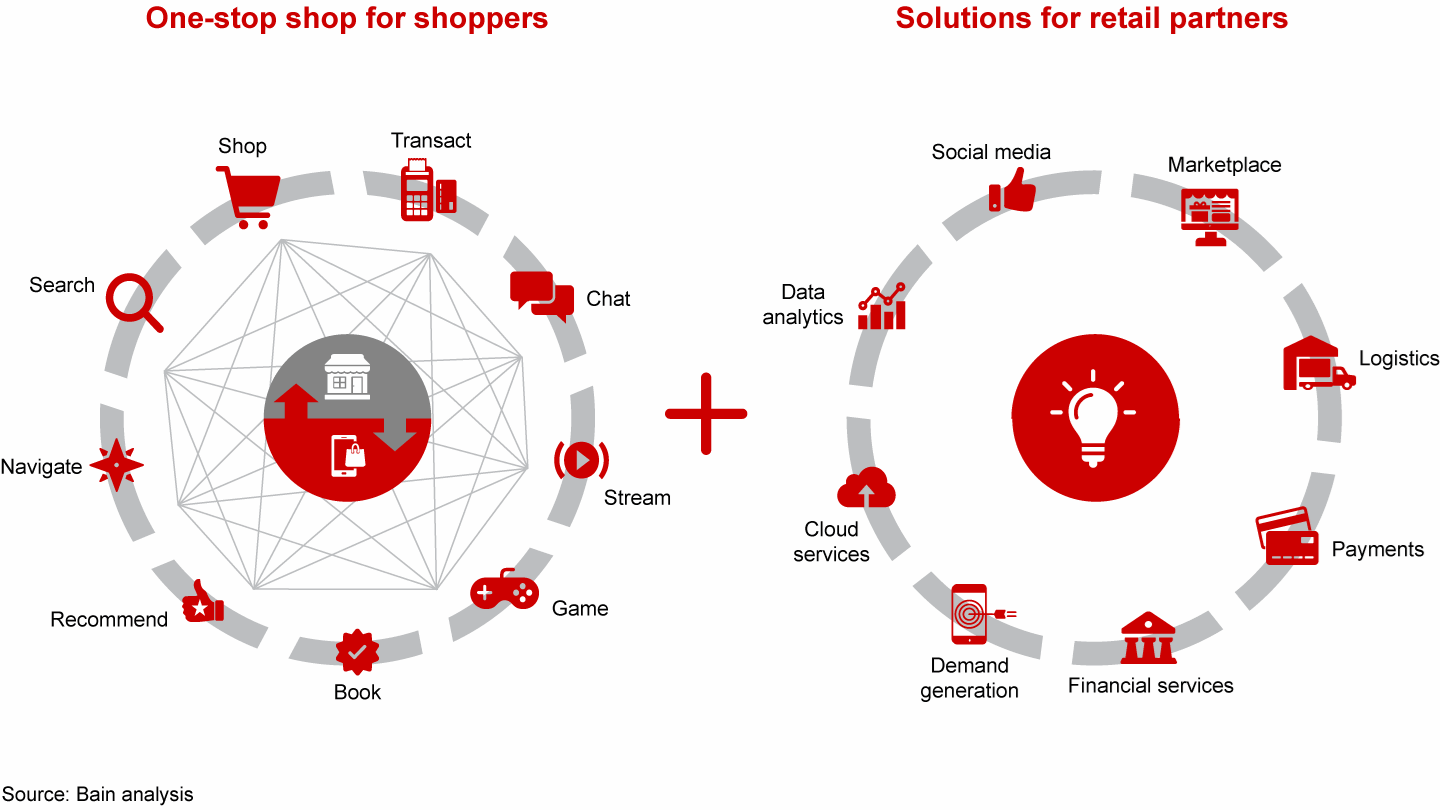
Some elements of the Amazon ecosystem, such as its extensive fulfillment network, have played starring roles during the holiday season for years. This year proves no different. The company has removed minimum order requirements for free shipping, and it’s made more than 3 million SKUs eligible for same-day delivery this holiday season. Other business areas, such as Amazon payments and home services, may create a scary scenario for retailers in the future, but for now, they are too small to affect this year’s holiday results. What will be front and center from Amazon this year?
Amazon lights up during the holidays
For most retailers, the holidays deliver a critical fourth-quarter sales infusion. For Amazon, the last two months of the year are about extending its lead over e-commerce competitors in the fastest-growing channel for retail spending. And many of these new holiday shoppers turn into long-term customers. The company came into this year’s holiday season controlling an estimated 43% of the US online retail market. Even though Amazon lowered its global fourth-quarter earnings forecast, in the US, we expect the company to outgrow the market and capture an even larger share of e-commerce sales by the end of 2018 (see Figure 2).
Amazon’s share of e-commerce spending jumps during the second half of the year

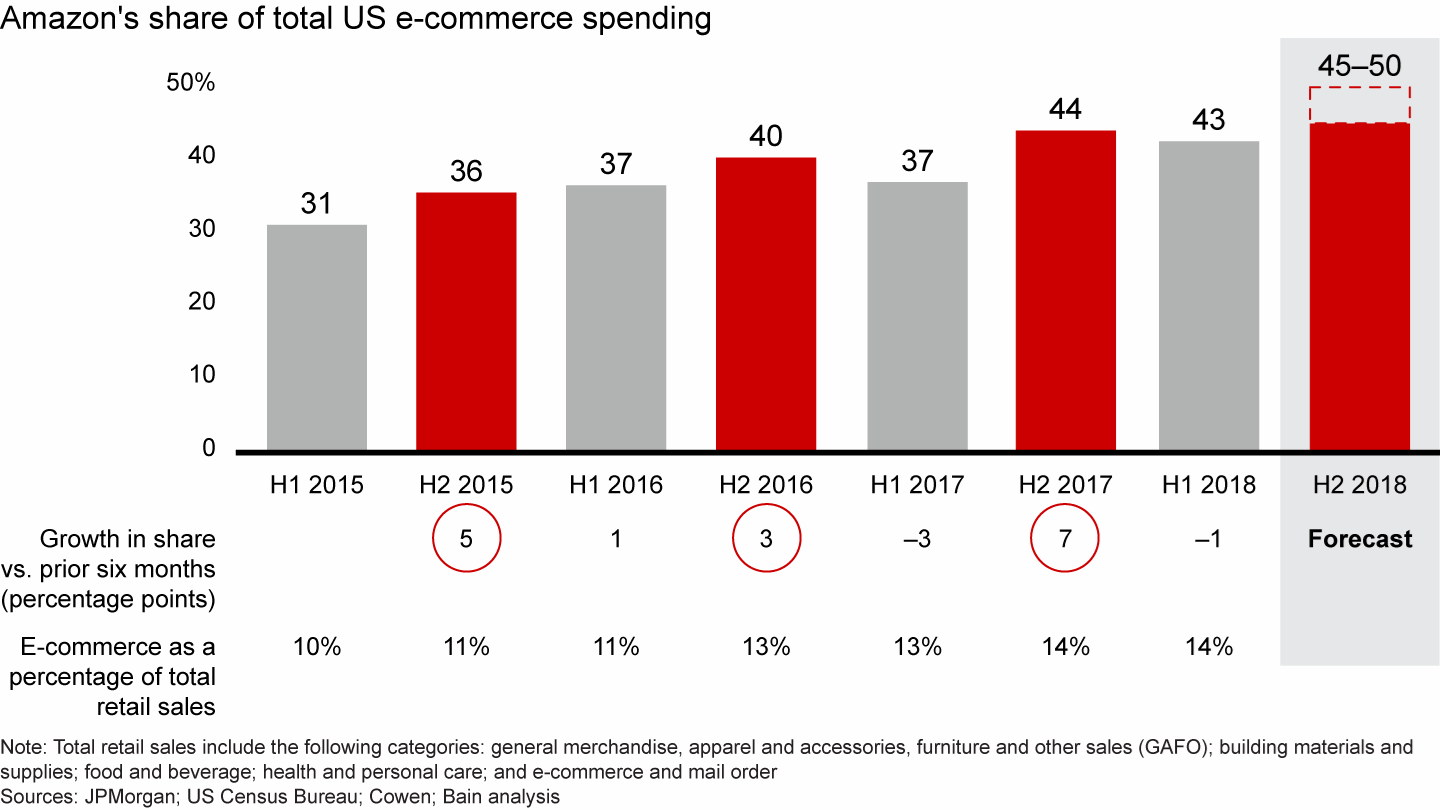
Amazon’s vast selection, customer reviews, low-price reputation and large Prime member base create a virtuous cycle that makes the company the leading starting point for e-commerce search. Its loyal customers, exemplified by its Prime member base, are the lifeblood of the retail ecosystem that the company is building. That said, Amazon doesn’t rest on its laurels. It has continued to innovate and find ways to turn its traffic edge into even bigger sales and share advantages.
Amazon’s conversion rate—that is, the portion of its online product page views that result in a sale—ranged from 13% to 16% in key gift categories, such as toys and video games, from January through October last year, according to Jumpshot. That was triple the rate of nine other major retailers we analyzed, which converted 3% to 4%. Amazon’s rate jumped by as much as 5 percentage points during last year’s holiday season, while competitors reaped only moderate gains of 1 to 3 percentage points (see Figure 3).
Amazon’s conversion rate jumps more than competitors’ in key categories during the holidays

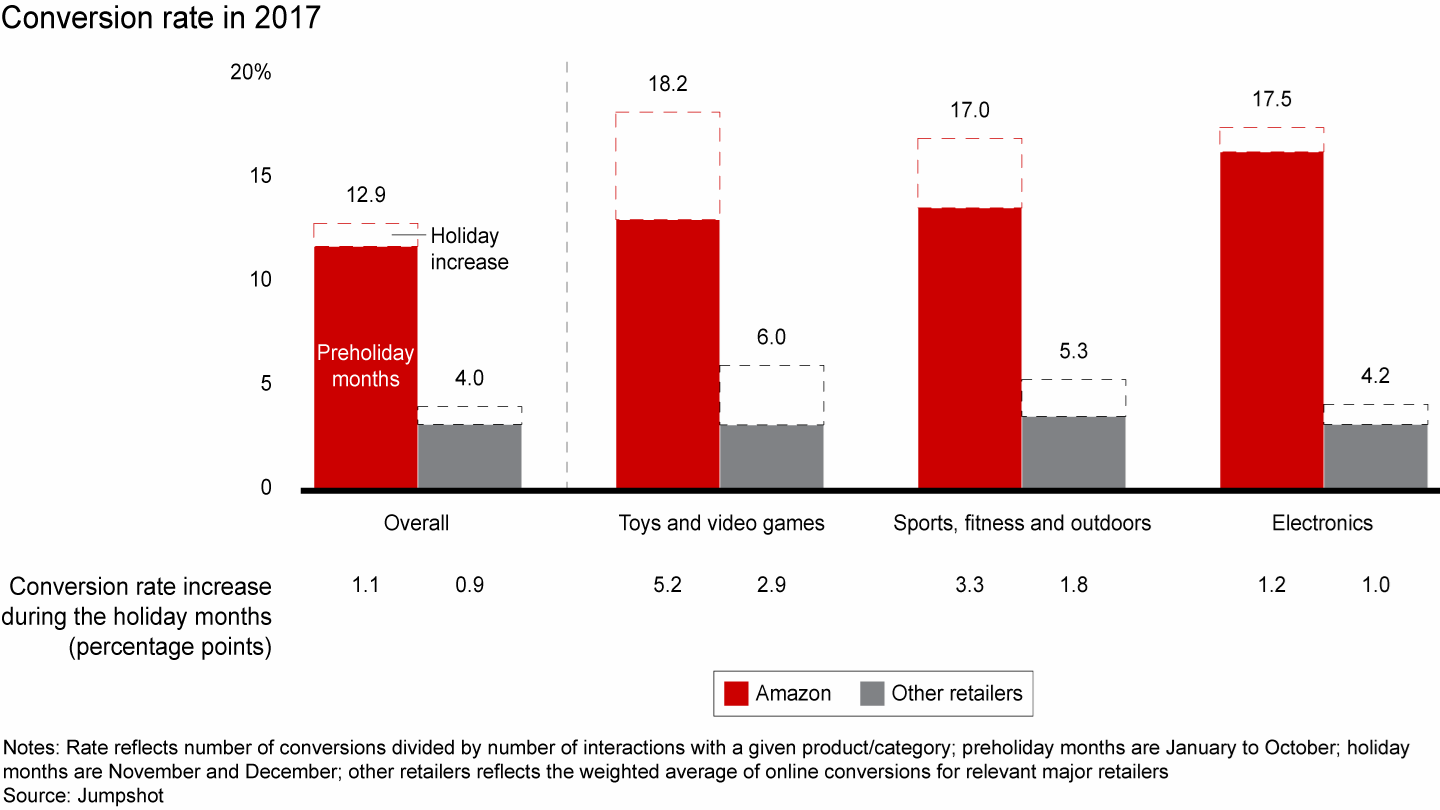
Amazon began this year’s holiday season in an even stronger position, with a conversion rate of 14% to 18% in these same gift categories. If the company’s rate gain matches last year’s, Amazon could increase its online holiday transactions by more than 20% compared with last year.
Amazon’s 70 million to 80 million US Prime members are increasingly valuable over time. Based on analysis we conducted with Earnest Research, looking at actual credit card spending, we found that Prime members’ spending increases 16% annually during the first four years after enrollment. That’s four times the rate of US retail spending growth, which rose 3.8% annually during that time. Prime members also increase their average monthly spending on Amazon by more than 50% during the holiday season (see Figure 4), doubling the industry’s 22% average surge.
Prime members’ monthly spending rose 52% during the 2017 holidays

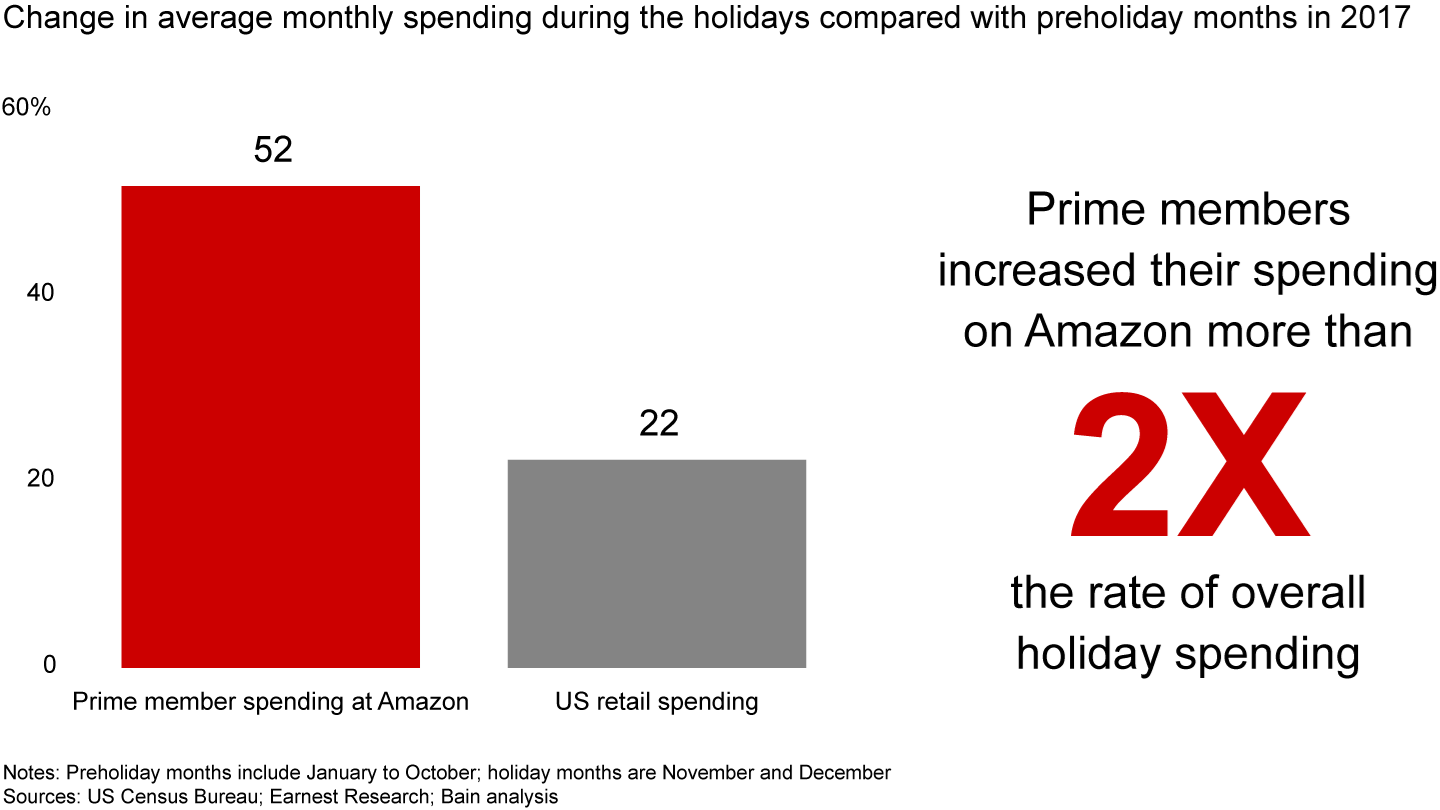
Amazon also knows that certain purchases by Prime members are likely to boost future spending and ultimately their customer lifetime value. For example, customers typically increase spending by 6 to 10 times after purchasing Amazon Fresh, creating a baby registry or getting approved for an Amazon credit card. This detailed knowledge helps Amazon make critical promotional investments to gain Prime members’ share of wallet. Increasing share of wallet and becoming a one-stop shop across categories both reflect the company’s broader ecosystem strategy.
What to expect from Amazon this holiday season
Amazon enters the holiday season as a leader in customer advocacy across many categories. Its customer-centric model has earned it a consistent industry-leading Net Promoter Score®—a measure of a customer’s likelihood to recommend a store or brand2—according to research we conducted with ROI Consultancy Services (see Figure 5). Even though the company ranks above average in every category and in the top quartile across half of the categories we considered, Amazon continues to experiment with the customer experience approaches that set it apart.
Amazon’s Net Promoter Score® is above the median in key retail categories

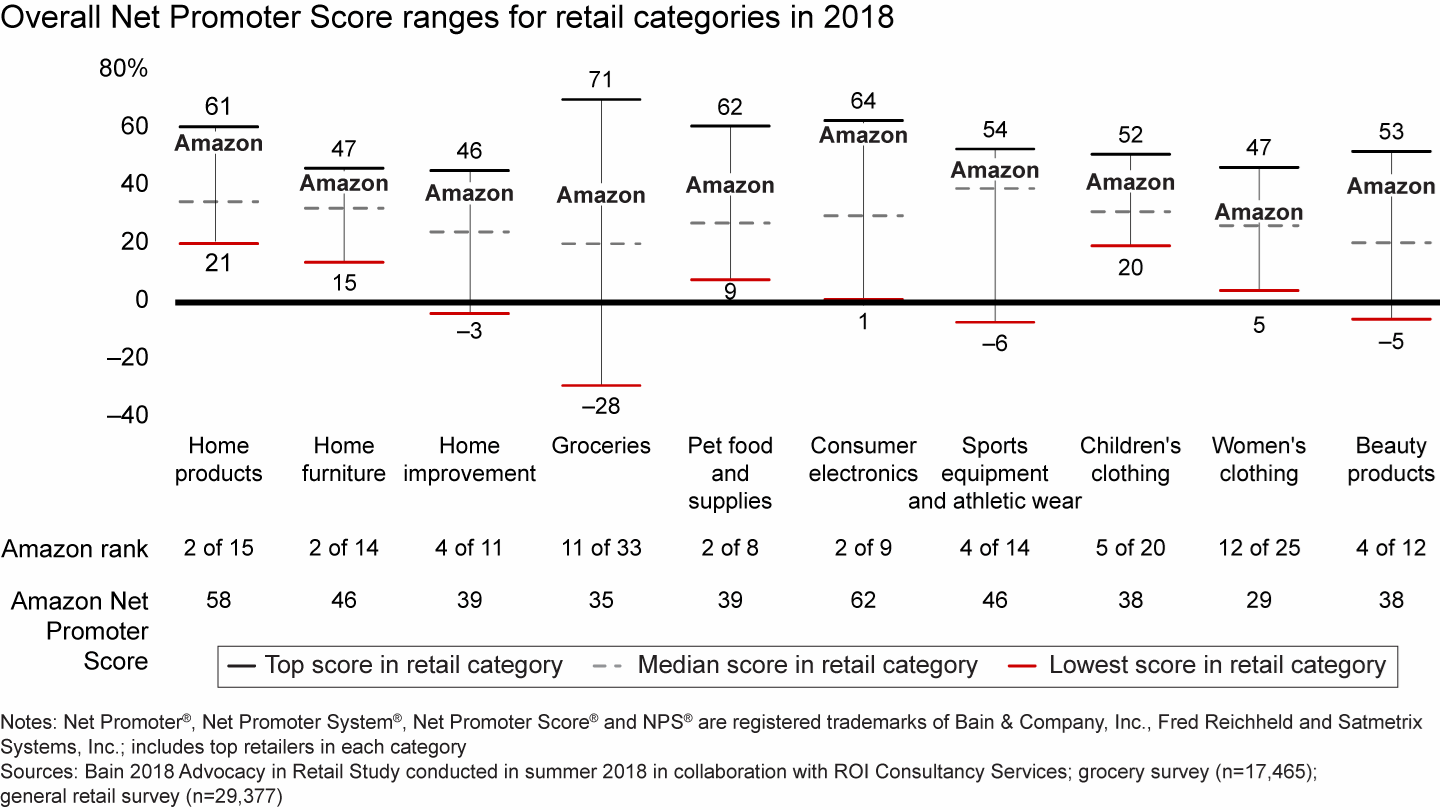
A year after Amazon’s Whole Foods Market acquisition, the company aims to transcend its status as the leading online retailer to become the top retailer, period—one that can meet all of a customer’s shopping needs in his or her preferred channel. Here’s what that means for this holiday season.
A merchandise assortment with more private label focus
Amazon has always offered an outsized product assortment, with nearly 600 million SKUs in the US vs. the estimated 70 million SKUs in Walmart’s US online marketplace or the 142,000 SKUs in an average US Supercenter. This year, Amazon has stocked more private label goods than ever, promoting them at the top of search results. They include both its branded electronic devices as well as its lines of generic and Amazon-only branded products.
Amazon also upgraded its signature gadgets this year, which made up 30% of its top 50 products sold last holiday season, according to research we conducted with Pyxis. This includes voice-enabled Echo devices, Kindle e-readers and Fire media products that are projected to yield more than $5 billion in sales this year. Not surprisingly, Amazon has timed new launches to appear under this year’s Christmas trees: In September, the company released new versions of the Echo Dot, Show and Plus, and it introduced the Echo Auto for cars, the Echo Sub subwoofer and Echo Wall Clock. Last month, Amazon started taking preorders for its new Kindle Paperwhite reader, which is lighter and thinner than previous iterations, and it’s waterproof. These devices appear prominently in its early Black Friday sales promotions. We expect to see continued emphasis during the holiday season, particularly for all things Echo.
Voice is an important channel in Amazon’s ecosystem. While Amazon commands the biggest share of voice device sales in the US today—more than 60% vs. Google’s 25%—Google sold more smart speakers in the first quarter than Amazon. It’s still early days in a market that will likely transform how shoppers interact with brands, and the data and advertising revenue that device makers can capture along the way has high potential. That potential is poised to grow even further as these voice devices start adding screens as well. Additionally, while Amazon hasn’t fully rolled out paid voice advertising to Alexa devices yet, a new capability might reveal what’s soon to come. Alexa is now able to redirect users to relevant “skills” when faced with a question, which opens the door for more Amazon control over response results.
Amazon is not only promoting device sales, it’s encouraging owners to use them. Bain research shows that only an estimated 9% of voice device owners have used them to shop, though they routinely use them to play music, answer basic questions and check the weather. Last year, the company promoted its voice technology by offering early Black Friday deals to users who shopped by voice. This year, Amazon has even teamed with poultry purveyor Butterball to offer turkey preparation advice on Thanksgiving via Alexa.
In addition to its high-tech products, Amazon has tripled its number of private label brands to 130 over the past year, according to TJI’s Amazon Brand Database. Some analysts expect private label sales to generate $7.5 billion in 2018, excluding Whole Foods, a 50% increase from last year. Amazon’s signature electronics make up approximately 75% of private label sales. While most other brands are small, many are growing at exponential rates. Here’s an update on some of Amazon’s other private label lines.
- AmazonBasics. The company’s low-priced range of products, which includes everything from generic HDMI cables to yoga mats and baking supplies, made up 85% of Amazon’s private label sales in 2017 (excluding electronics and Whole Foods sales), and sales have climbed 46% over the past 12 months, according to Numerator's InfoScout OmniPanel, which analyzes shoppers’ receipts. Much of that growth is due to Amazon’s efforts to push its private label goods through its own channels. For example, Amazon's private label batteries account for half of AA and AAA batteries sold on its website, tripling the 15% slice of generic battery sales across all US retailers.
- Apparel brands. Almost 75% of Amazon’s 130 private label brands are related to apparel. Morgan Stanley analysts expect Amazon to become the largest apparel retailer by the end of this year. Amazon has been most competitive so far with lower-priced, midmarket clothing items. Its Amazon Essentials, a brand that includes low-cost everyday clothing, grew more than 13 times compared with the previous year.
- Grocery brands. At the beginning of the year, Whole Foods 365 was the best-selling private label brand in Amazon’s portfolio, after electronics and AmazonBasics. Sales of Wickedly Prime—the line of snacks, drinks and condiments that Amazon offers exclusively to Prime members—have grown more than 80% since 2017, according to Numerator.
- Designer partnerships. In Amazon’s usual test-and-learn style, the company has begun to experiment with the kinds of designer partnerships that Target and Kohl’s made popular. In October, Amazon introduced Now House by Jonathan Adler, a line of furniture and décor by the famed designer.
Amazon’s own brands have long seemed to benefit from search preference and Vine reviews (Amazon’s invitation-only review program). More recently, Amazon has added a new section on certain pages titled, “Top Rated from Our Brands.” Amazon has devoted prime real estate to this feature, locating it directly after its sponsored products—a more prominent placement for private label products than even several months ago.
Even faster delivery
Amazon changed consumers’ expectations for delivery speed when it launched Prime in 2005, offering two-day shipping as a membership benefit. The five- to eight-day delivery window that many retailers built their logistics network to serve was no longer acceptable, especially for last-minute holiday shoppers.
Leading retailers have upped the ante on fast shipping this holiday season, dropping fees and minimum spending requirements to draw more shoppers. Target said it would provide free two-day shipping without a minimum purchase from November 1 to December 22 this holiday season, using its stores as fulfillment centers to accomplish the feat. Walmart is offering free two-day delivery with a $35 minimum.
Meanwhile, Amazon is setting new standards again; it announced earlier this week that it would make two-day shipping available to all shoppers, including non-Prime customers, without a spending requirement. As part of a pilot program, the company is also letting a select group of Prime members choose the date for their packages to arrive, allowing them to plan deliveries around their schedules. Amazon has also made 3 million SKUs available for same-day delivery as a Prime benefit this holiday, shrinking the delivery window further at Whole Foods locations in 63 US cities where customers can receive two-hour delivery.
Bringing online benefits into stores
Industry doomsayers predicted that Amazon’s rise would be the end of brick-and-mortar stores, but those predictions haven’t come to pass—especially not for Amazon. Physical stores worldwide accounted for $8.6 billion of Amazon’s sales during the first half of 2018, a figure the company aims to increase with a US store footprint that now includes 586 sites, including 473 Whole Foods locations (see Exhibit A).
That said, Amazon’s foray into brick and mortar is anything but traditional. The company is adding its unique spin to tried-and-true retail tactics to improve the customer experience this year.
- Curating assortments with (new) customer data. Retailers have long used historical sales data to inform assortment decisions. However, Amazon is now systematically using customer reviews and online data to inform store assortment. Its new Amazon 4-star store concept offers a curated assortment of products that Amazon customers have rated with at least four stars. For the holidays, Amazon 4-star customers will be able to browse items that are “Amazon Most Wished For.” Similarly, Amazon Books locations are using online data to create store displays that highlight the most preordered products or books most shipped to the local area.
- Ensuring congruent pricing across channels. Omnichannel retailers that use dynamic pricing online have typically charged different prices for the same products that are sold in stores, often to customers’ disappointment. It is impossible to change physical price tags and signage multiple times a day. At the handful of Amazon 4-star stores and Amazon Books locations, customers don’t face that frustration. Amazon 4-star uses digital screens while Amazon Books uses QR codes and digital price tags to communicate item pricing to consumers. This allows Amazon to sync online and in-store prices while making necessary competitive and inventory level adjustments throughout the holiday season. This system also requires less labor to prepare aisles for consumers.
- Eliminating checkout pain. In several of its store formats, Amazon has provided customers with a way to bypass the long lines at checkout. Amazon Go uses cameras and sensors to identify customers’ purchases and bill them directly via its mobile app. This is one step further than Target’s “Skip the Line” and Walmart’s “Check Out with Me” services, which allow consumers to check out with associates anywhere in the store using handheld devices. Amazon’s recent fashion pop-up in London also used its “SmileCode” QR-code technology to let customers order from their smartphones rather than check out traditionally, arming roaming associates with credit card readers.
- Broadening pickup options. For customers who prefer to pick up packages, Amazon has increased the number of its self-serve Amazon Locker kiosks to more than 2,800 from 2,000 in 2017. More than 75% of Whole Foods locations have Amazon Lockers inside. Additionally, Hub by Amazon, a package management solution for apartments, is now available to more than 500,000 residents. For the 30% of consumers who have experienced porch theft, expanded pickup options add security and convenience.
Prices that continue to squeeze competitors
Customer experiences are critical, but price remains an important consideration for many consumers, especially during the holidays. According to research we conducted with ROI Consultancy Services, shoppers said “value for the money” was one of the most important purchase criteria in 9 out of 10 major product categories. When asked how well Amazon provided “value for the money,” consumers rated Amazon in the top 20% of retailers. Research we conducted with Numerator showed that Amazon matches or beats competitors’ prices on key products more than 75% of the time (see Figure 6).
Amazon matches or beats other retailers’ product prices more than 75% of the time

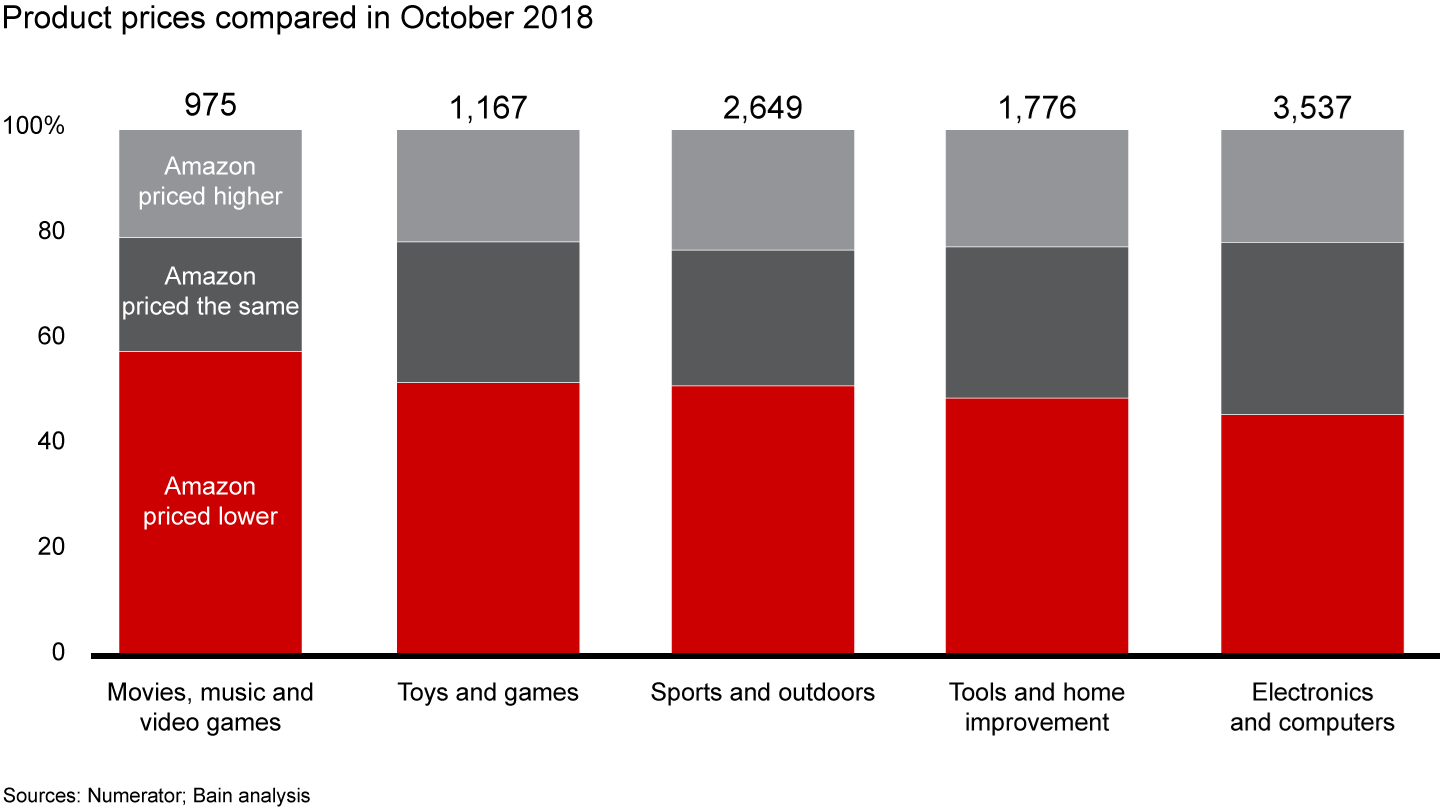
While most eyes are on Amazon’s sales and potential share gains this holiday season, we would be remiss not to address the company’s focus on profits as well. While the company continues to invest heavily in growing outside of the US, its North America business earned $2.8 billion in 2017 and $5 billion this year through the third quarter, excluding its Amazon Web Services cloud storage service. Actions taken to spur this change, among others, include an increased focus on vendor terms and requirements, such as stringent packaging standards and supply chain terms; and greater reliance on automation, including for merchandising and allocation decisions, such as delisting or deprioritizing items that “can’t realize a profit.”
Time will tell if Amazon’s actions will pull off the triple flip of growth, share gains and increased profit this holiday season.
Competing in an Amazon World
As Amazon builds and strengthens elements of its ecosystem this holiday season and beyond, strategic questions will loom large for most retailers. Companies will need to anticipate where Amazon is going and decide if they should participate in the Amazon ecosystem, build their own, or play it solo. They will need to decide what to build or acquire, when to borrow or partner with another company. Answers will depend on a company’s competitive advantages and cost position, access to capital, proprietary assets, and, of course, customer loyalty. Ensuring that customers have reason and desire to shop is paramount to a retailer’s success, and there are proven strategies to encourage that behavior.
In our experience, leading retailers use seven approaches to set themselves apart from competitors. While few retailers get all seven right, the most successful master three or four.
- Strengthen exclusive offerings. Retailers that offer exclusive products worry less about a race to the bottom in pricing.
- Make discovery seamless. Customers want to find products easily throughout their shopping experience, both online and in stores, and they don’t always start knowing exactly what they want. Social media provides another way for customers to discover brands and products outside of stores and websites.
- Invest in inspirational merchandising. Products, packaging, websites and store displays can help companies forge emotional connections with consumers, and inspire customers to buy collections of items rather than single pieces.
- Have an authoritative brand voice. Everything from packaging to store display to web pages is an opportunity to show what a brand stands for and tell its story.
- Excel at customer intimacy and customer-centric service. Customers are more engaged when they receive personal attention, whether it is in stores or through targeted marketing campaigns.
- Reinvent stores as omnichannel systems. Brick-and-mortar locations play a crucial role as omnichannel hubs. Stores serve a broader purpose in their surrounding areas, providing everything from fulfillment and reverse logistics to postsale service and support. The “store of the future” is likely to take many forms as businesses experiment with different store formats that integrate consumer customization and new technologies.
- Use advanced analytics and Agile testing approaches to improve continuously. Powerful analytics tools can parse significant amounts of data in no time, allowing retailers to prototype and test solutions rapidly. These tactics help companies make decisions based on actual data, not guesses.
Many retailers are applying some of these approaches. Few are pursuing them at scale or at the ideal pace, often because of cost constraints. All of these initiatives require investments in technology, people and change. Successful retailers will fuel innovation and growth—whether it’s through differentiation, new capabilities, promising partnerships or asset acquisitions—with sustained cost management, using tactics such as zero-based budgeting and continuous redesign. No retailer can afford to overspend on anything that doesn’t deliver value to customers, especially if they want to compete with Amazon.

Retail Holiday Newsletter 2018
Bain’s annual Retail Holiday Newsletter series looks at the tactics and innovations that retailers are using to attract and delight shoppers.
Looking forward: Future release dates and topics
Here’s a preview of our upcoming newsletters.
- Issue No. 3 (late November): Holiday Halftime Report and Labor Insights
- Issue No. 4 (mid-December): Modern Merry Marketing
- Issue No. 5 (mid-January): Postholiday Recap and 2019 Outlook
Please let us know if you have other topics you would like to learn more about by emailing us at RetailHolidayNewsletter@bain.com. We look forward to sharing holiday headlines with you and hearing from you throughout the holiday season.
Appendix
Amazon has 586 retail locations in the US, across a variety of formats

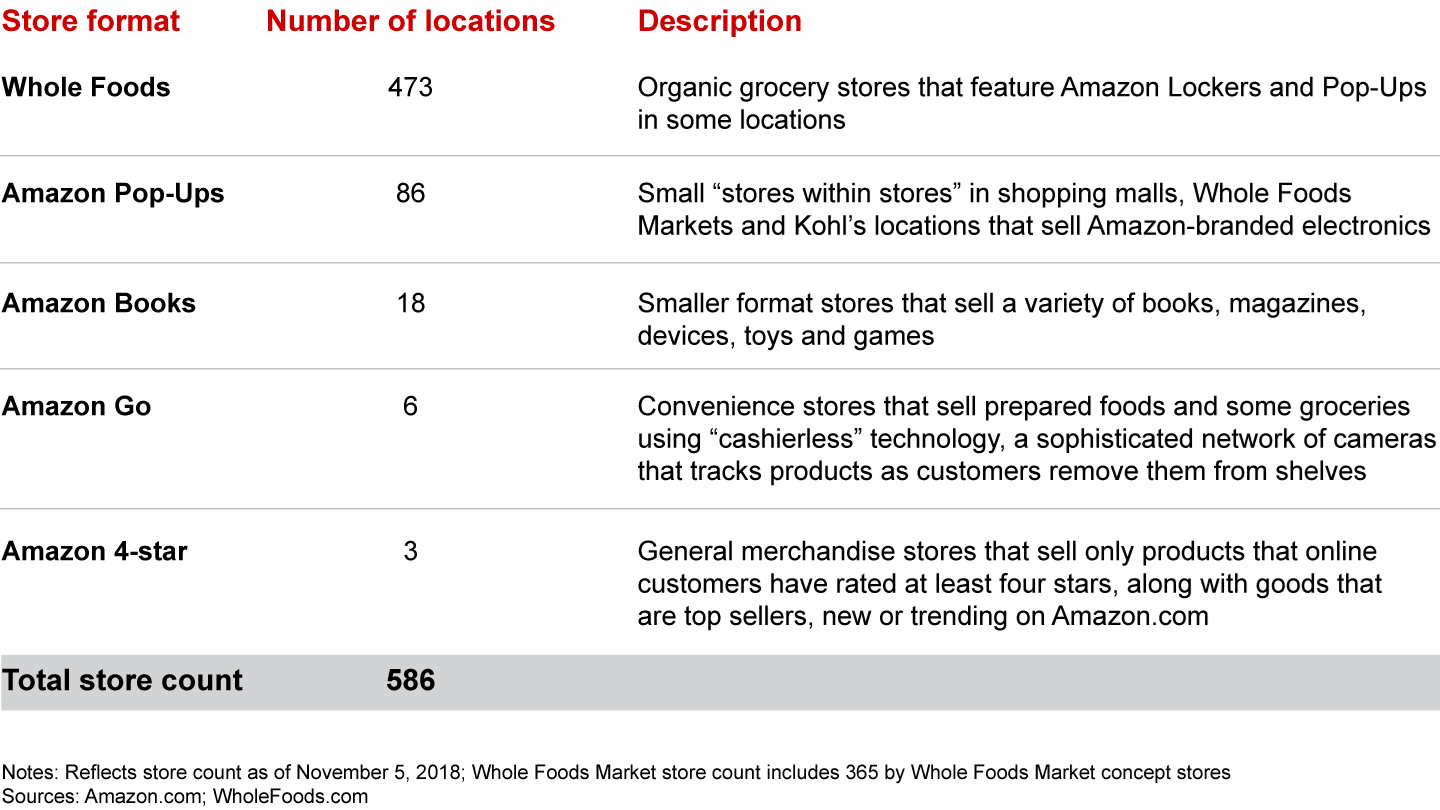
To compete against Amazon, successful retailers focus on three or four of the following critical approaches

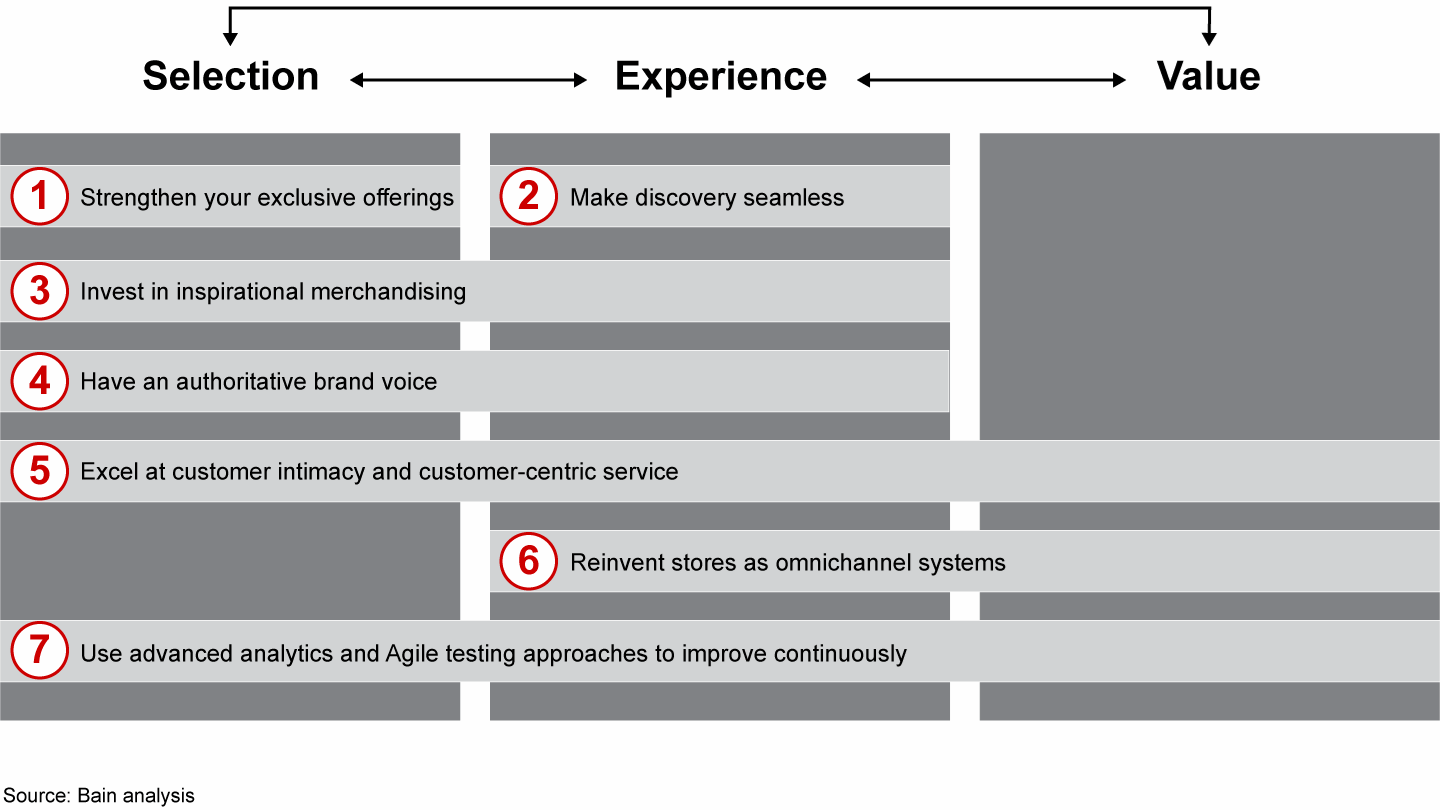
About Our Research Partners
Earnest Research provides market and consumer research that draws from the transaction data of millions of anonymous US-based consumers to consultants, investors and corporate clients. Using a proprietary full-wallet methodology and longitudinal cohort analysis, Earnest Research provides insight into consumer behavior trends and a comprehensive, unbiased look into competitive market dynamics. To learn more about Earnest Research, visit www.earnestresearch.com.
Green Street Advisors, an independent research firm, advises participants in the commercial real estate industry, providing them with unbiased insights and excellent service. Green Street offers public market REIT research in North America and Europe, covering more than 120 REITs; the firm also provides US private market research on the top 50 metropolitan statistical areas. To learn more about Green Street, visit www.greenstreetadvisors.com.
Jumpshot provides insights about online user actions that help e-commerce companies and brands gauge how and where customers are clicking and buying. The company’s real-time, anonymized global panel tracks 5 billion actions a day across 100 million devices. Jumpshot’s clients include major companies in industries such as consumer products, media, technology and healthcare. To learn more about Jumpshot, visit www.jumpshot.com.
Numerator is a market-intelligence firm that brings together omnichannel marketing, merchandising and sales data for brand, retail and agency clients. Owned by Vista Equity Partners, Numerator connects omnichannel purchase data (powered by the InfoScout OmniPanel) and comprehensive path data to deliver a detailed view of the consumer shopping and purchase experience. To learn more about Numerator, visit www.numerator.com.
Placer.ai is an advanced foot-traffic analytics platform that generates location-specific insights, helping retailers gain a deeper understanding of audiences and competition. Headquartered in Silicon Valley, Placer.ai enables its customers to make data-driven decisions based on precise human movement analytics. To learn more about Placer.ai, visit www.placer.ai.
Pyxis is a consumer-behavior analytics firm that analyzes billions of e-commerce and in-store purchases conducted by millions of consumers. Pyxis uses SKU-level data and proprietary algorithms to generate detailed reports about market share, market size, customer loyalty and pricing power for leading consumer companies. To learn more about Pyxis, visit www.pyxisintel.com.
ROI Consultancy Services, a provider of Bain Certified Net Promoter Score studies, offers full-service research, marketing and sales automation, and digital agency support to consultants, investors and corporate clients. To learn more about ROI Consultancy Services, visit www.roiconsultancyservices.com.
-
Selected References (click to expand)
Bain & Company has included in this document information and analyses based on the sources referenced below as well as our own research and experience. Bain has not independently verified this information and makes no representation or warranty, express or implied, that such information is accurate or complete. Projected market and financial information, analyses and conclusions contained here are based (unless sourced otherwise) on the information described above, and Bain’s judgments should not be construed as definitive forecasts or guarantees of future performance or results. Neither Bain & Company nor any of its subsidiaries or their respective officers, directors, shareholders, employees or agents accept any responsibility or liability with respect to this document.
“Alexa, What Happens Next?” Morgan Stanley, Amazon Disruption Symposium presentation, September 28, 2018.
Amato-McCoy, Deena M. “Amazon’s two-hour delivery from Whole Foods hits additional markets.” Drug Store News, October 26, 2018.
“Amazon Announces Updated Echo Dot, Echo Plus and All New Echo Sub.” Deccan Chronicle, September 21, 2018.
Amazon’s Black Friday sales page. Amazon.com, accessed October 30, 2018.
Anand, Priya. “The Reality behind Voice Shopping Hype.” The Information, August 6, 2018.
Barclays Equity Research. “Unpacking the Current State of Prime.” Analyst report, September 11, 2018.
Broida, Rick. “These Prime Day Deals Are Still Available—but Only via Alexa.” CNET, July 18, 2018.
Butler, Sarah. “Amazon opens pop-up fashion shop in central London.” The Guardian, October 23, 2018.
Chen, Cathaleen. “Amazon Primed for Gain With Private Label Apparel.” Business of Fashion, July 23, 2018.
Cheng, Andria. “One More Sign Walmart Is Serious When It Comes To Fighting Amazon.” Forbes.com, January 21, 2018.
Chicago Board Options Exchange. “CBOE Volatility Index: VIX [VIXCLS].” Database, accessed November 1, 2018.
Conditt, Jessica. “For Amazon, better skills mean bigger ad revenue.” Engadget, September 20, 2018.
Cowen Equity Research. “Cowen’s CFO Meetings: Greatness through Innovation and Cowenvision Video.” Company update, October 4, 2018.
Evans, Katie. “Store customers flow from Home Depot’s website.” Digital Commerce 360, June 4, 2018.
“Form 10-K for the Fiscal Year Ended December 31, 2017.” Amazon.com, February 1, 2018.
“Form 10-Q for the Quarterly Period Ended September 30, 2018.” Amazon.com, October 25, 2018.
Fox Rubin, Ben. “Amazon Hub lockers now available to 500,000 US residents.” CNET, June 19, 2018.
Franck, Thomas. “Apple downgraded for a second time after its earnings — shares down 9.2% since report.” CNBC, November 5, 2018.
Garcia, Tonya. “Target launching ‘Skip-the-Line’ checkout technology, will open at 5 p.m. on Thanksgiving.” Marketwatch, November 5, 2018.
Goode, Lauren and Michael Calore. “Is There an Echo in Here? All the Hardware Amazon Announced.” Wired, September 20, 2018.
"Google Beats Amazon to First Place in Smart Speaker Market.” Canalys, press release, April 24, 2018.
Green, Dennis. “Whole Foods' brand is becoming Amazon's most powerful weapon in taking on the grocery industry.” Business Insider, January 17, 2018.
Greenwald, Will. “Hands On With Amazon's New Echo Dot, Plus, Input, and More.” PC Magazine, September 21, 2018.
Goldberg, Jason. “What Competitors Are Missing About Amazon's New 4-Star Retail Concept.” Forbes.com, October 3, 2018.
Heater, Brian. “Amazon is letting users choose the day packages are delivered.” Techcrunch, November 3, 2018.
Howland, Daphne. “Amazon store count tops 600.” Retail Dive, October 17, 2018.
Kim, Eugene. “Amazon Has Been Promoting Its Own Products at the Bottom of Competitors' Listings.” CNBC.com, October 2, 2018
Kim, Eugene. “Amazon plunges 10% on revenue and guidance miss.” CNBC.com, October 25, 2018.
Martin, Olivia. “Jonathan Adler Just Launched a New Home Collection on Amazon.” Town & Country, October 18, 2018.
Meyersohn, Nathaniel. “Amazon offers free shipping on all orders for the holidays.” CNN, November 5, 2018.
“New Ways Amazon Is #Deliveringsmiles This Holiday.” Dayone, the Amazon blog, November 1, 2018.
Nunez, Michael. “Amazon's new Kindle Paperwhite shows e-readers can still get better.” Mashable, October, 16, 2018.
“Our Retail Divisions.” Walmart.com.
“Real Disposable Personal Income: Per Capita.” Federal Reserve Bank of St. Louis, graph, November 5, 2018.
“Retail and Food Service Sales.” US Census Bureau, graph, accessed October 30, 2018.
S&P 500, graph, October 31, 2018.
Siegel, Rachel. “Amazon just upped the ante in the race for free holiday shipping.” The Washington Post, November 5, 2018.
Sullivan, Mark. “Here’s Everything Amazon Announced at Its Big Alexa Event in Seattle.” Fast Company, September 20, 2018.
“Surveys of Consumers: Preliminary Results for October 2018.” University of Michigan, data release, October 25, 2018.
“The Amazon Black Friday 2017 Deals Early Release through Alexa Voice Shopping Starts Today.” I4U News, November 22, 2017.
“The Conference Board Consumer Confidence Index Increased Again in October.” The Conference Board, press release, October 30, 2018.
“The Employment Situation — October 2018.” US Bureau of Labor Statistics, press release, November 2, 2018.
“The Independent Global List of Amazon Private Label and Exclusive Brands.” TJI Amazon Brand Database, accessed November 5, 2018.
“The Smart Audio Report.” National Public Radio and Edison Research, Fall–Winter 2017.
Thomas, Lauren. “2018 Could Be a Breakout Year for Amazon's Private Labels.” CNBC.com, December 20, 2017.
Thomas, Lauren. “Amazon's 100 million Prime members will help it become the No. 1 apparel retailer in the US.” CNBC.com, April 19, 2018.
Thomas, Lauren. “Target's battle plan for the holidays: Free two-day shipping, more staff and toys.” CNBC.com, October 23, 2018.
Vincent, James. “Amazon Offers Alexa-only Deals to Encourage You to Shop with Your Voice.” The Verge, July 8, 2016.
Warren, Tom. “Amazon’s Alexa Voice Deals Return for This Year's Prime Day.” The Verge, July 5, 2017.
“Whole Foods Stores With Amazon Lockers See Rise In ‘Micro’ Visits.” PYMNTS.com, March 26, 2018.
Wiggers, Kyle and Khari Johnson. “Amazon Debuts Fire TV Recast DVR and Echo Auto In-car System.” VentureBeat, September 20, 2018.
Wolverton, Troy. “Amazon's stock falls 9%, as disappointing revenue, guidance seem to outweigh standout Q3 earnings.” Business Insider, October 25, 2018.
1 Green Street Advisors determines mall grades for each property based on merchandise mix, productivity, location, and condition/appeal.
2 The Net Promoter Score® is derived by asking consumers, “On a scale of zero to 10, how likely would you be to recommend this company (or this product) to friends and colleagues?” Ratings of 9 or 10 indicate promoters; 7 and 8, passives; and zero through 6, detractors. The score is simply the percentage of promoters minus the percentage of detractors.
Net Promoter®, Net Promoter System®, Net Promoter Score® and NPS® are registered trademarks of Bain & Company, Inc., Fred Reichheld and Satmetrix Systems, Inc.